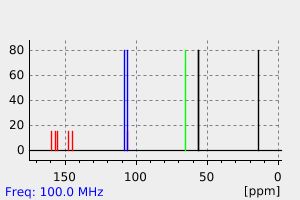2-ethoxy-6,7-dimethoxy-(4H)-3,1-benzoxazine-4-one | 107717-48-6
中文名称
——
中文别名
——
英文名称
2-ethoxy-6,7-dimethoxy-(4H)-3,1-benzoxazine-4-one
英文别名
2-ethoxy-6,7-dimethoxy-4H-3,1-benzoxazine-4-one;6,7-dimethoxy-2-ethoxy-4H-3,1-benzoxazin-4-one;2-Ethoxy-6,7-dimethoxy-4H-3,1-benzoxazin-4-on;6,7-dimethoxy-2-ethoxy-4-oxo-1,3-benzoxazin;2-ethoxy-6,7-dimethoxy-4H-3,1-benzoxazin-4-one;2-ethoxy-6,7-dimethoxy-3,1-benzoxazin-4-one
CAS
107717-48-6
化学式
C12H13NO5
mdl
——
分子量
251.239
InChiKey
PZCMIWLJDPILGG-UHFFFAOYSA-N
BEILSTEIN
——
EINECS
——
-
物化性质
-
计算性质
-
ADMET
-
安全信息
-
SDS
-
制备方法与用途
-
上下游信息
-
文献信息
-
表征谱图
-
同类化合物
-
相关功能分类
-
相关结构分类
物化性质
-
熔点:169-170 °C
-
沸点:387.4±52.0 °C(Predicted)
-
密度:1.29±0.1 g/cm3(Predicted)
计算性质
-
辛醇/水分配系数(LogP):2
-
重原子数:18
-
可旋转键数:4
-
环数:2.0
-
sp3杂化的碳原子比例:0.33
-
拓扑面积:66.4
-
氢给体数:0
-
氢受体数:6
反应信息
-
作为反应物:描述:2-ethoxy-6,7-dimethoxy-(4H)-3,1-benzoxazine-4-one 在 甲醇 、 sodium hydride 作用下, 以 苯 为溶剂, 反应 9.0h, 生成 3-acetyl-6,7-dimethoxy-4-hydroxyquinolin-2(1H)-one参考文献:名称:Synthesis of 3-Substituted 4-Hydroxyquinolin-2-ones via C-Acylation Reactions of Active Methylene Compounds with Functionalized 3,1-Benzoxazin-4-ones摘要:DOI:10.3987/com-99-8508
-
作为产物:描述:2-(ethoxycarbonylamino)-4,5-dimethoxybenzoic acid 在 三聚氯氰 、 三乙胺 作用下, 以 PEG-400 为溶剂, 以90%的产率得到2-ethoxy-6,7-dimethoxy-(4H)-3,1-benzoxazine-4-one参考文献:名称:分步合成2-乙氧基-(4 H)-3,1-苯并恶嗪-4-ones的简便方法摘要:描述了一种简单实用的路线,可通过邻氨基苯甲酸衍生物与碳酸二乙酯的偶合反应,然后氨基甲酸酯加合物与环戊二酸酯快速环化,合成2-乙氧基-((4 H)-3,1-苯并恶嗪-4-酮。室温下,在PEG中使用氰尿酰氯和N,N'-二环己基碳二亚胺等脱氢环化剂。在温和的反应条件下,只需对反应混合物进行简单的后处理,即可获得高收率的产品。DOI:10.1016/j.cclet.2012.01.028
文献信息
-
Guanidinum Chloride as Dehydrocyclization Agent in the Synthesis of 2-Fuctionalized (4<i>H</i>)-3,1-Benzoxazine-4-ones作者:Farzad Nikpour、Asrin Bahmani、Forugh Havasi、Mahnaz Sharafi-KolkeshvandiDOI:10.1002/jhet.1649日期:2014.1A facile and expedient route for the synthesis of 2‐ethoxy‐ and 2‐(ethylcarboxylate)‐(4H)‐3,1‐benzoxazine‐4‐ones is described using guanidinium chloride as a safe and convenient dehydrocyclization agent. High yields of the products obtain under mild reaction conditions without need to use of any catalyst and with easy work‐up of the reaction mixture.
-
Nickel-catalyzed Cycloadditions of Benzoxazinones with Alkynes: Synthesis of Quinolines and Quinolones作者:Nobuyoshi Maizuru、Tasuku Inami、Takuya Kurahashi、Seijiro MatsubaraDOI:10.1246/cl.2011.375日期:2011.4.5A nickel-catalyzed cycloaddition has been developed where readily available benzoxazinones react with alkynes to afford substituted quinolines or quinolones. The specific cycloaddition can be achie...
-
2-Oxy-4H-3,1-benzoxazin-4-one derivatives and related compounds申请人:SYNTEX (U.S.A.) INC.公开号:EP0206323A1公开(公告)日:1986-12-302-Oxy-4H-3,1-benzoxazin-4-ones represented by the formula: and the pharmaceutically acceptable acid addition salts thereof, pharmaceutical compositions with serine protease inhibiting effects, therapeutic uses of such compounds and methods for their manufacture are disclosed.
-
Synthesis and Pharmacological Evaluation of 1-Oxo-2-(3-piperidyl)-1,2,3,4- tetrahydroisoquinolines and Related Analogues as a New Class of Specific Bradycardic Agents Possessing I<sub>f</sub> Channel Inhibitory Activity作者:Hideki Kubota、Akio Kakefuda、Toshihiro Watanabe、Noe Ishii、Koichi Wada、Noriyuki Masuda、Shuichi Sakamoto、Shin-ichi TsukamotoDOI:10.1021/jm0301742日期:2003.10.1A series of 1-oxo-2-(3-piperidyl)-1,2,3,4-tetrahydroisoquinolines and related analogues were prepared and evaluated for their bradycardic activities in isolated right atrium and in anesthetized rats. (+/-)-6,7-Dimethoxy-2-1-[3-(3,4-methylenedioxyphenoxy)propyl]-3-piperidyl}-1,2,3,4-tetrahydroisoquinoline (4) was chosen as a lead, and structural modifications were performed on the tetrahydroisoquinoline ring and the terminal aromatic ring. The modifications on the tetrahydroisoquinoline ring revealed that the 1-oxo-1,2,3,4-tetrahydroisoquinoline ring system was optimum structure for both in vitro potency and in vivo efficacy. Furthermore, methoxy, ethoxy, and methoxycarbonyl groups were identified as preferable substituents on the terminal aromatic ring. One of the 1-oxo-1,2,3,4-tetrahydroisoquinoline derivatives, (R)-10a, was further evaluated for its bradycardic activity and inhibitory activity against I-f currents. Compound (R)-10a demonstrated potent bradycardic activity in rats with minimal influence on blood pressure after oral administration. The compound also showed inhibition of I-f currents (IC50 = 0.32 muM) in guinea pig pacemaker cells.
-
Leistner; Simon; Wagner, Pharmazie, 1987, vol. 42, # 10, p. 694 - 695作者:Leistner、Simon、Wagner、SturzebecherDOI:——日期:——
表征谱图
-
氢谱1HNMR
-
质谱MS
-
碳谱13CNMR
-
红外IR
-
拉曼Raman
-
峰位数据
-
峰位匹配
-
表征信息
同类化合物
(2,3-二氢-3-氧代-4H-1,4-苯并恶嗪-4-基)乙腈
高氯酸恶嗪4
颜料紫37
颜料紫23
颜料紫20
靛红酸酐
阿莫沙平-d8
阿莫沙平
阿帕利酮
阳离子翠蓝GB
间苯二酚蓝
邻乙酰胺苯甲酸內酯
达罗红
载色体 I
贝莫拉旦
试卤灵钠盐
试卤灵乙酸酯
试卤灵丁酸酯
试卤灵-d6
试卤灵
解草酮
西硝地尔
螺[苯并[d][1,3]噁嗪-4,4'-哌啶]-2(1H)-酮盐酸盐
螺[4H-3,1-苯并噁嗪-4,4’-哌啶]-2(1H)-酮
荧光兰
苯醇胺菌素
苯草灭
苯并[a]吩恶嗪-9-酮
苯并[a]吩恶嗪-5-酮
苯(甲)醛,4-[2-(4-羰基-2H-1,3-苯并噁嗪-3(4H)-基)乙氧基]-
苄氧基试卤灵
花青
艾替伏辛
耐尔蓝-铂四氯化物络合物
羟苯并吗啉
美西拉宗
美罗培南中间体
罗丹宁蓝
碱性蓝6
碱性蓝3
碱性蓝 3
硝酸盐
盐酸阿扎司琼
盐酸阿扎司琼
盐酸洛沙平-d8
盐酸奥达特罗
甲酸7-[(2-氰基乙基)乙胺基]-3-(乙基甲基氨基)-2-甲基苯并噁嗪-5-正离子
甲酚紫
甲氧基异酚恶唑
甲基{4-[(6-硝基-2H-1,4-苯并噁嗪-3-基)氨基]苯基}乙酸酯







